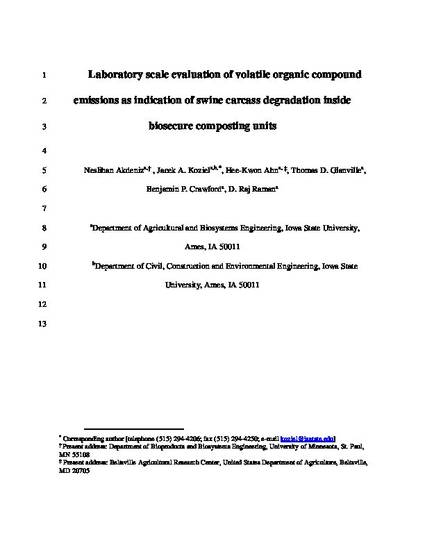
Biosecure livestock mortality composting systems have been used to dispose of diseased livestock mortalities. In those types of system, visual inspection of carcass degradation is not possible and monitoring VOCs (volatile organic compounds) released by carcasses is a new approach to assess progress of the composting process. In this study, field-scale livestock mortality composting systems were simulated and a laboratory scale composting system with aerobic and anaerobic test units was designed to collect VOC samples from the headspace of decaying plant materials (70 g dry weight) and swine tissues (70 g dry weight) at controlled operating temperatures. Headspace samples were collected with SPME (solid phase microextraction) and analyzed by a GC–MS (gas chromatography–mass spectrometry) system. Among the 43 VOCs identified, dimethyl disulfide, dimethyl trisulfide, and pyrimidine were found to be marker compounds of the mortality composting process. These compounds were only found to be produced by decaying swine tissues but not produced by decaying plant materials. The highest marker VOC emissions were measured during the first three weeks, and VOCs were not detected after the 6th week of the process, which indicates degradation processes were completed and compost materials microbially stabilized (no additional VOC production). Results of respiration tests also showed that compost materials were stabilized. Results of this study can be useful for field-scale composting operations but more studies are needed to show the effects of size and aeration rate of the composting units.
Available at: http://works.bepress.com/jacek_koziel/172/

This is a manuscript of an article published as Akdeniz, Neslihan, Jacek A. Koziel, Hee-Kwon Ahn, Thomas D. Glanville, Benjamin P. Crawford, and D. Raj Raman. "Laboratory scale evaluation of volatile organic compound emissions as indication of swine carcass degradation inside biosecure composting units." Bioresource Technology 101, no. 1 (2010): 71-78. DOI: 10.1016/j.biortech.2009.07.076. Posted with permission.